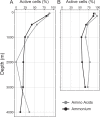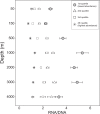Single-cell view of deep-sea microbial activity and intracommunity heterogeneity
- PMID: 36202927
- PMCID: PMC9750969
- DOI: 10.1038/s41396-022-01324-6
Single-cell view of deep-sea microbial activity and intracommunity heterogeneity
Abstract
Microbial activity in the deep sea is cumulatively important for global elemental cycling yet is difficult to quantify and characterize due to low cell density and slow growth. Here, we investigated microbial activity off the California coast, 50-4000 m water depth, using sensitive single-cell measurements of stable-isotope uptake and nucleic acid sequencing. We observed the highest yet reported proportion of active cells in the bathypelagic (up to 78%) and calculated that deep-sea cells (200-4000 m) are responsible for up to 34% of total microbial biomass synthesis in the water column. More cells assimilated nitrogen derived from amino acids than ammonium, and at higher rates. Nitrogen was assimilated preferentially to carbon from amino acids in surface waters, while the reverse was true at depth. We introduce and apply the Gini coefficient, an established equality metric in economics, to quantify intracommunity heterogeneity in microbial anabolic activity. We found that heterogeneity increased with water depth, suggesting a minority of cells contribute disproportionately to total activity in the deep sea. This observation was supported by higher RNA/DNA ratios for low abundance taxa at depth. Intracommunity activity heterogeneity is a fundamental and rarely measured ecosystem parameter and may have implications for community function and resilience.
© 2022. The Author(s), under exclusive licence to International Society for Microbial Ecology.
Conflict of interest statement
The authors declare no competing interests.
Figures






References
-
- Arístegui J, Gasol JM, Duarte CM, Herndl GJ. Microbial oceanography of the dark ocean's pelagic realm. Limnol Oceanogr. 2009;54:1501–29. doi: 10.4319/lo.2009.54.5.1501. - DOI

